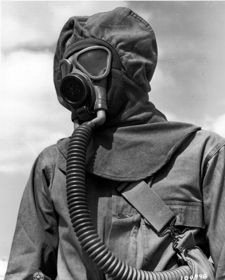Terrorism with Chemical and Biological Weapons: Health Issues Involved  Bioterrorism includes the release of bacteria, viruses, or other biological agents in a terrorist attack. Biological agents can spread through the air, in water, or through the food supply. Some may spread person-to-person, such as smallpox, and others, such as anthrax, cannot. Chemical terrorism is the release of chemical agents or toxins in order to kill or severely injure people. Chemical agents can be absorbed through the skin, the mucous membranes, the eyes, or through the gastrointestinal tract if consumed. Bioterrorism includes the release of bacteria, viruses, or other biological agents in a terrorist attack. Biological agents can spread through the air, in water, or through the food supply. Some may spread person-to-person, such as smallpox, and others, such as anthrax, cannot. Chemical terrorism is the release of chemical agents or toxins in order to kill or severely injure people. Chemical agents can be absorbed through the skin, the mucous membranes, the eyes, or through the gastrointestinal tract if consumed.
Both biological and chemical weapons are extremely dangerous to one’s health and safety. While some biological and chemical agents have low mortality rates, they can cause serious and lasting illness. Smallpox and plague can leave surviving victims severely disfigured, for example. The mortality rates of biological agents differ. The mortality rate for tularemia (rabbit fever or deer fly fever) is five to 30 percent, Q-fever is one percent, smallpox is 35 percent in un-vaccinated people, botulism is 65 percent, plague is 60 percent, and untreated pneumonic plague is 50 to 90 percent. Two viral hemorrhagic fevers have high mortality rates: Marburg has a lethality rate of over 25 percent and Ebola of 50 to 80 percent. Untreated inhaled anthrax has nearly a 100 percent mortality rate. Sarin gas and Ricin are also extremely toxic. The toxicity and mortality rates of chemical agents vary widely by exposure conditions and concentration. The death rate from exposure to mustard gas is two to three percent, although long-term complications may contribute to higher mortality. VX gas has a 50 percent mortality rate. The psychological impact of biological and chemical terrorism affects more people than do the actual chemical and biological agents. Responses to actual or threatened terror attacks include fear, anger, and social isolation. People may become depressed and fear being alone or fear being in a crowded situation. Sleep problems and nightmares may occur. Many people who are not exposed to chemical or biological agents during an attack may seek treatment out of fear, which can impede the health care system’s ability to treat the infected. The following resources provide health information on the physical and psychological effects of biological and chemical weapons, tips for coping with terrorist attacks, and tips on how citizens can protect themselves from exposure to biological and chemical agents in the event of an attack.
General Information
- NATO Handbook on Medical Aspects of WMD attacks: Details diagnosis, treatment, and identification of biological, chemical, and nuclear weapons.
- Bioterrorism: Information from the Centers for Disease Control on specific bioterrorism agents and how medical professionals can diagnose infection and respond.
- Medical Aspects of Chemical and Biological Warfare: Treatment and health effects of biological and chemical warfare agents.
- Bioterrorism Response: Links to pdf articles on public health response to anthrax, botulinum, plague, smallpox, and tularemia attacks.
- Biological and Chemical Weapons FAQs: Includes information on how to deal with chemical or biological attacks, vaccinations, and medical responses to attacks.
- Treating Biological Threats: Information for consumers on evaluating medical treatments and products.
- Arm Yourself with Information: Information on diseases and health conditions, including those caused by bioterrorism and chemical agents.
- Chemical Weapons: Includes information on signs and symptoms of exposure and treatment of illness and injury related to chemical weapons.
- A Physician’s Guide: A guide to signs, symptoms, and treatment of anthrax, smallpox, and pneumonic plague.
Coping Pictures
- Mustard Gas: Site includes a photo of a soldier exposed to mustard gas, of soldiers wearing gas masks, and of the effect of poison gas on soldiers without gas masks.
- Anthrax: Images of cutaneous anthrax.
- Plague: Images of patients with plague.
- Tularemia: Images of patient with tularemia.
- Viral Hemorrhagic Fevers: Information on symptoms and treatment; includes image.
- Biological Agents: Images of cutaneous symptoms of various biological agents.
Prevention and Screening - Biological Attack: Tips on protecting yourself after a biological attack, includes information on hygiene, symptoms of illness, and what to do in case of attack.
- Protective Clothing and Respirators: Recommendations for protective clothing and respirators for use against biological weapons.
- Biowarfare Precautions: Precautions against anthrax, botulinal toxins, Enterotoxin B, Cyanide, and other biowarfare agents.
- Precautions against Biological Attack: Information on the signs of a biological attack, protective clothing, and steps for citizens to take to protect themselves.
- Anthrax: Prevention and treatment of anthrax, also includes information on the signs and symptoms of anthrax.
- Anthrax Protection: Guidelines to prevent or minimize exposure to anthrax and for those exposed to anthrax.
- Prepare for a Biological Attack: Guidelines on preparation for a biological attack and what to do if you are exposed to a biological weapon.
- Preparation for a Chemical or Biological Attack: Guidelines for citizens on what to do in case of a biological or chemical attack.
- Bioterrorism Defense: Includes information on effective medical products, the emergency use authorizations of medical products, and the defense of blood supply safety in the event of a terrorist attack.
This article was written by Mike Haldas, co-founder and managing partner of CCTV Camera Pros. If you found it useful, please share it.
| Shop for video surveillance products |
|---|
| | | |
|---|
|









 Bioterrorism includes the release of bacteria, viruses, or other biological agents in a terrorist attack. Biological agents can spread through the air, in water, or through the food supply. Some may spread person-to-person, such as smallpox, and others, such as anthrax, cannot. Chemical terrorism is the release of chemical agents or toxins in order to kill or severely injure people. Chemical agents can be absorbed through the skin, the mucous membranes, the eyes, or through the gastrointestinal tract if consumed.
Bioterrorism includes the release of bacteria, viruses, or other biological agents in a terrorist attack. Biological agents can spread through the air, in water, or through the food supply. Some may spread person-to-person, such as smallpox, and others, such as anthrax, cannot. Chemical terrorism is the release of chemical agents or toxins in order to kill or severely injure people. Chemical agents can be absorbed through the skin, the mucous membranes, the eyes, or through the gastrointestinal tract if consumed.
